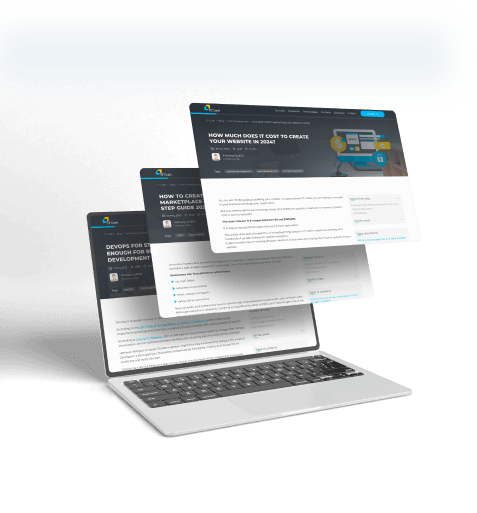For many, working remotely continues to increase in popularity. The demand for new and innovative apps also increases to help us stay fit, healthy, and productive.
The demand for digital products and services has skyrocketed. Those health and fitness businesses that pivoted—pivoted to success.
Remote training and hybrid workout became the new normal. Market research anticipates users will continue to use fitness apps. Working remotely means working out from anywhere to stay healthy.
What about you? Are you ready to pivot quickly and grab one of the many opportunities? Do you want to meet the needs and demands of people worldwide?
Isn’t it time to create your workout app and achieve financial success?
Check out our mobile app development roadmap, so you get started and get launched
1
What are key fitness app market statistics?
When COVID started, it brought great opportunities for those who wanted to develop a fitness app. People globally were recommended to avoid crowded places for the sake of health and safety. Thus, people considered fitness applications an efficient and popular alternative instead of visiting on-site gyms.
Any high-quality app that helped keep our bodies and minds healthy within the confines of our homes was a clear winner.
The number of fitness app users across the USA grew by 20+%—from 68.7 million in 2019 to 86.3 million in 2022. This statistic includes all smartphone users who opened a fitness app at least once a month.
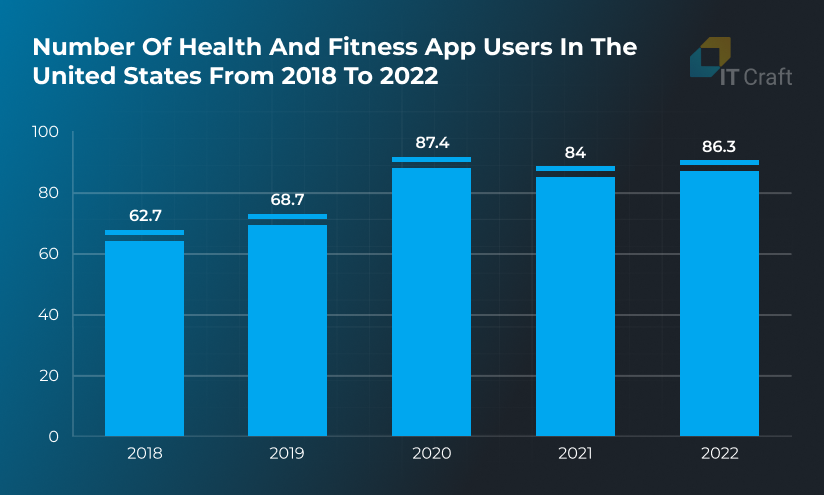
Tracking devices are also gaining popularity; sales continue to grow.
U.S. Fitness App Market from 2020 to 2030

Workout and weight loss apps are currently among the most popular fitness apps in 2023.
We all know why….#COVID 19-23.
According to Forbes, currently, the top 10 leading positions in the market for fitness belong to the following fitness applications:

-
Pros
- Real-time, in-app messaging with friends or workout partners
- Guided meditations
- Free guides for healthy eating, stress reduction, sugar reduction, improved sleep, and more
-
Cons
- Limited free version includes access to all workouts, live leaderboard, and real-time messaging with friends.
- Only annual and six-month subscriptions are available

-
Pros
- Most workouts take less than 30 minutes
- Varying levels of intensity across several types of workouts
- Workouts are led by the company’s well-known trainers, including Autumn Calabrese, Joel Freeman, Jericho McMatthews, Shaun T, etc.
-
Cons
- No free version
- Live classes are only available with BODi upgrade

-
Pros
- Virtual guidance from Nike master trainers
- Personalized workout recommendations
- Minimal workout equipment required for most workouts
-
Cons
- Apple Watch integration for heart rate monitoring needs improvement
- Cannot access more than one recommended structured program at a time
- Android users occasionally report video and workout timer glitches

-
Pros
- Create your own workouts and share them with friends
- A calendar-based planner helps you stay organized and committed
- All data is synced and backed up to the cloud
-
Cons
- No live classes
- No nutrition or diet information included

-
Pros
- Free version saves unlimited workouts and three custom routines
- Auto countdown timer helps record rest breaks
- Track progress with graphs and automatically backs up data to the cloud
-
Cons
- No live classes
- No social connectivity

-
Pros
- Connects with other health apps, including FitBit, MapMyRun, Apple Health, and more
- Personalized dashboards display nutrition and workout data
- Track macros, carbs, protein, etc.
- Includes more than 100 self-guided workout routines
-

-
Pros
- Expert-led exercise demonstrations promote proper form and safety
- Customized workout options available
- Connect easily with other Jefit members for tips, feedback, and support
-
Cons
- Most workouts require equipment
- Heart rate monitoring and tracking not included

-
Pros
- All workouts are bodyweight based (no equipment needed)
- Shorter workouts
- Can compete with and encourage fellow app users
-

-
Pros
- Provides guided exercise tutorials by athletes and trainers
- Step-by-step exercises help ensure optimal performance
-
Cons
- No live classes
- No social connectivity
Visit Website
Leading fitness apps by revenue on Google Play include:
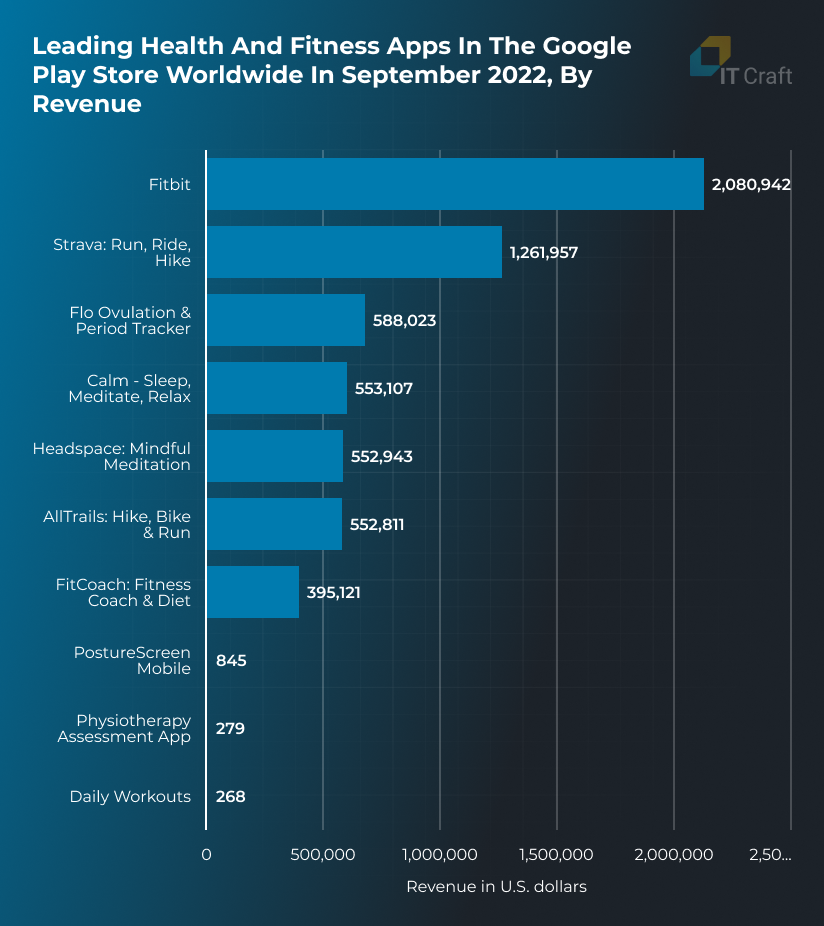
Revenue in the Fitness Apps segment is forecasted to hit $19.33bn in 2023. User penetration will be 9.76% in 2023 and is projected to reach 12.21% by 2027. The average revenue per user (ARPU) is expected to be $25.78.
2
What are the most sought-after fitness app types?
What are the most sought-after fitness app types currently in the market?
Workout fitness apps
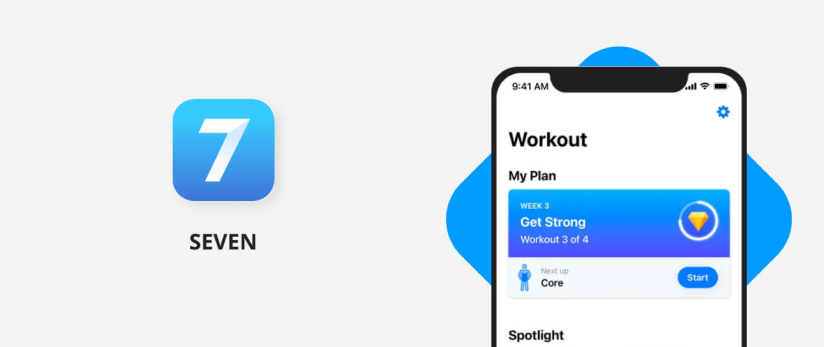
“Small habits lead to big changes.” 7-Minute Workout App – Seven
This statement helped drive Perigee’s 7-minute workout app, Seven, to monumental success. With over 54 million downloads, Seven is one of the best examples of how to build a fitness app for workouts. Super motivating and easy to use, it offers a seven-minute workout plan sorted by difficulty level. The plan contains a set of ready workouts. The workouts can be customized based on user needs.
Gamification makes the 7-mins challenge less stressful. Users have three “lives” at the beginning of a challenge. They must complete the set of exercises at least once a day. If they miss, they lose one life. With three lives lost, the challenge starts anew.
Every activity has instructions and audio guidance. The application offers a status system (beginner to advanced) to maintain motivation. Users can also go online to share results and inspirations.
The application provides coach recommendations and a personal training plan if the user has a paid subscription.
Personal training fitness apps
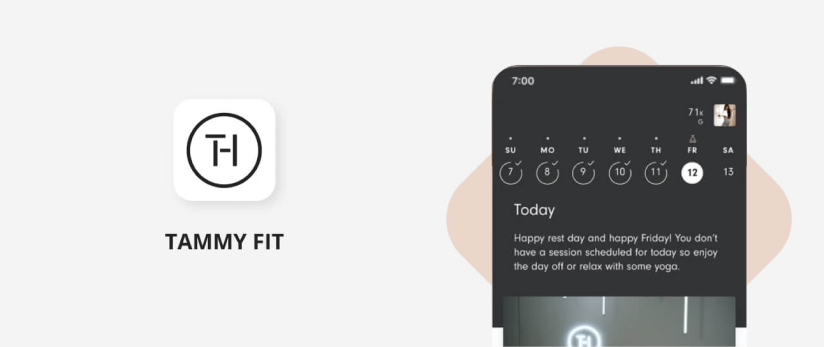
Tammy Fit application is one of the most popular fitness apps in the personal training category.
Tammy Hembrow, a highly rated fitness instructor, has created her own fitness app to help people get the body of their dreams
App users enter information about their desired fitness goals.
Based on the data, the app determines their current activity level.
Then it offers a plan:
- basic training
- post-pregnancy plan
- full-body workout sessions
Each plan includes three to five workouts per week.
Nutrition and calorie tracking apps
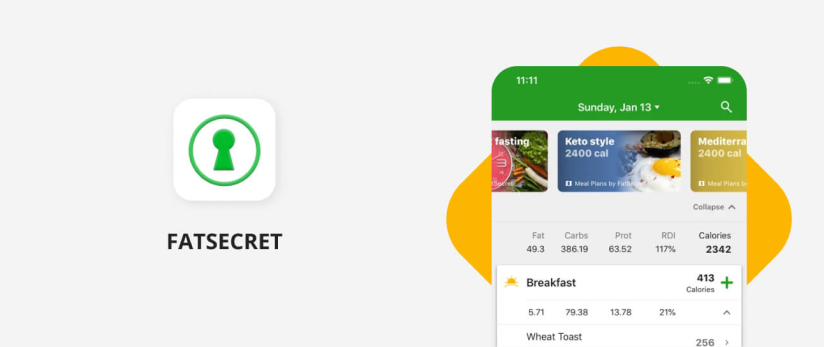
Nutrition and calorie tracking apps make it possible to search for nutritional information using a barcode or a photo scanner. This type of fitness app helps keep track of consumed calories and see progress in burning fat.
The app leader by the number of downloads is FatSecret app. It has a simple design, an intuitive interface, and a set of essential functions.
This mobile fitness app provides such features as:
- scan codes
- autocomplete
- products photo recognition
Users can also keep track of their eating habits by taking photos of what they eat. This fitness app can create schedules and compare calorie consumption and nutrients for a week or a month.
The app works in offline mode.
Activity tracking apps
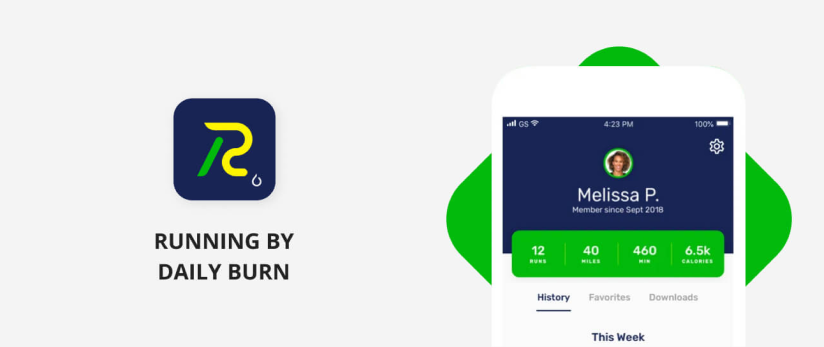
These fitness apps use data from wearable devices.
Users can:
- monitor their workouts
- measure jogging distances
- achieve their fitness goals
- count calorie intake
- track their progress
- control heart rate
and more.
Running by Daily Burn is among the top fitness apps of this type. This activity-counting application is rapidly gaining in popularity.
Running by Daily Burn asks users a few questions about their goals. It then creates a list of running plans to address those goals. Or users can select jogging plans based on various criteria, including pace, distance, etc. The app also offers a guided running session.
Running by Daily Burn offers a selection of warm-ups and relaxing videos designed specifically for runners.
Workout music apps
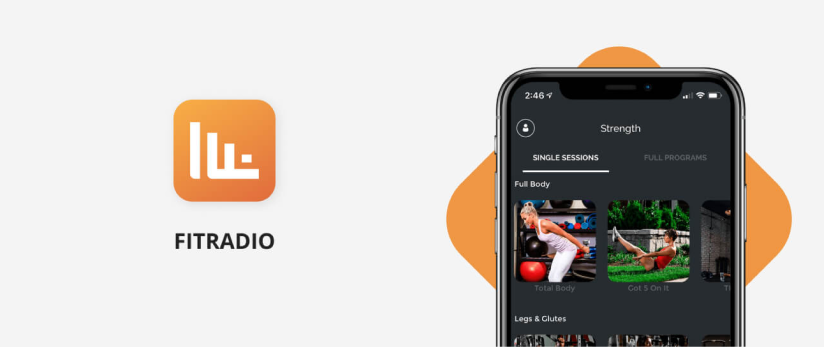
FitRadio is a fitness app designed to improve workouts. When users first launch FitRadio, they register with their email address or social network profile. This is all they need to do.
The entire UI has only four tabs:
- Music Genre – Users find many music genres to match their preferences.
- Stations – This contains a list of all popular radio stations that broadcast cool music for workouts; various genres are available.
- Favorites – This tab lets users create a favorite playlist.
- DJs – There is a list of DJs with their bios and the possibility to join their online broadcasting here. Users can add DJs to their lists of favorites.
Water intake control apps
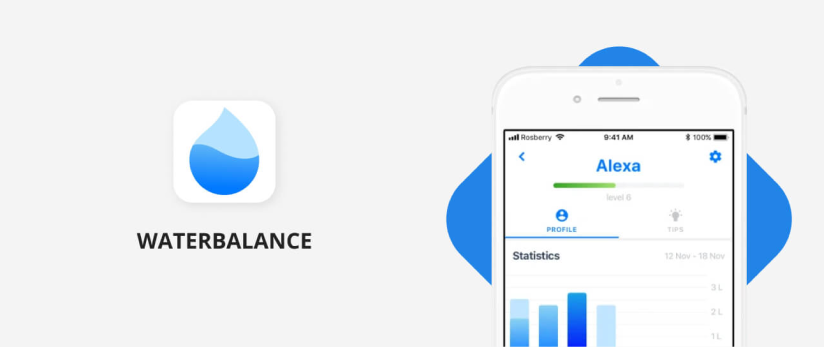
The Water intake application is probably the most popular in this category. Users are asked to specify their gender, age, weight, and level of physical activity. They also must provide their location. The app needs it to provide information on the weather forecast. The weather is an essential parameter when calculating the required amount of water.
It is simple to enter the volume of consumed liquid. Users tap on the plus sign, select the type of drink, and indicate the amount in milliliters. The app reflects liquid intake in percentage on their profile avatar.
The application also offers to push notifications about workouts and reminders to drink water. Users can get different badges to show their achievements.
DO YOU HAVE FITNESS APP IDEAS AND WANT A ROADMAP?
Contact us and get it for free!
Contact Us
3
How to make a fitness app: step-by-step guide
This short fitness application development guide helps future app owners correctly estimate efforts needed on their side for fitness mobile app development. It also helps form clear expectations from the development team.
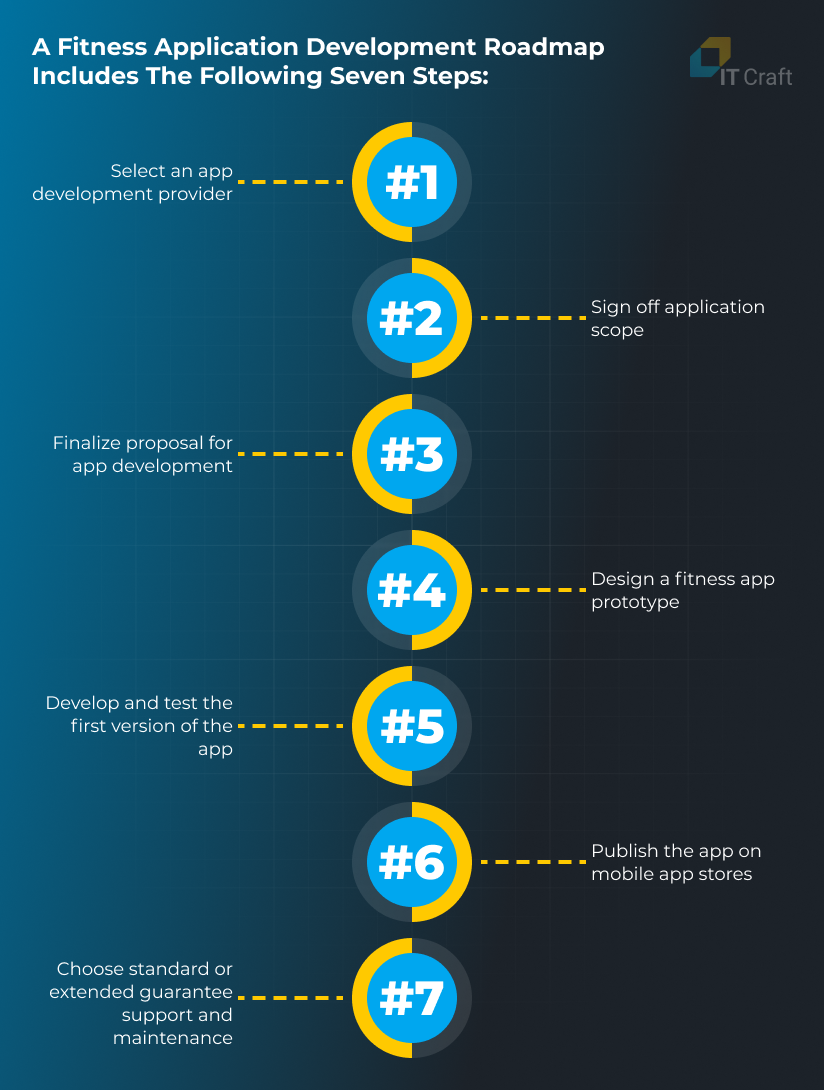
#1. Select an app development provider.
Outline your fitness app ideas and requirements. Discuss them with your selected fitness app developers. Any concerns about confidentiality? Ask them to sign a non-disclosure agreement (NDA) before discussing your future fitness app.
Finding a reliable provider can be challenging. To make is a little easier and significantly increase your chances of dealing with a trustworthy tech company, check out text and video reviews on the potential vendor’s portfolio, case studies, and testimonials.
Remember to surf the provider’s profile at independent rating sources like Upwork, GoodFirms, and Clutch.
#2. Sign off application scope.
After the requirements are clearly defined, a decent software provider must estimate the work scope. This will allow them to calculate the cost of your fitness app project.
Possessing a budget makes it possible to suggest the optimal team composition. It can be a team including a project manager, developer, QA, and designer.
If your budget can afford it, you can sign an extended team structure:
- Project manager
- Business analyst
- Developer
- Mobile developer
- DevOps
- QA engineer
- UI/UX designer
Also, it’s necessary to discuss a feature list and prioritize it. If you are greatly restricted on budget, competent specialists will help you define the must-have features to launch your product. After you monetize your app, you can then update your fitness application.
Within this stage, the fitness application developers estimate the project’s timeline so you can understand when an exact milestone is going to be delivered. Finally, the software provider will help you to select the best-fit tech stack.
#3. Finalize proposal for app development.
Both parties clarify the basics for ongoing cooperation. When both parties agree on the terms, they sign a contract. After signing the agreement, the project is assigned to a project manager. The PM monitors the development progress and communicates with the client.
When choosing a software provider, beware of extremely low service rates. Indeed, hourly rates vary depending on the geography, but when the price seems too low, it might indicate an unscrupulous company. If so, you risk receiving a poor app that needs to be completely rebuilt. Or you might receive no app at all because the company has disappeared with your money.
#4. Design a fitness app prototype.
A prototype demonstrates how the fitness app will work. This responsibility lies with the business analyst. The business analyst works through the app logic and presents the client with specifications. The specifications describe app functionality in detail, transitions between functionalities, business processes, main scenarios, and data transmission methods.
#5. Develop and test the first version of the app.
During this step, the designer and client determine the app’s style, including interface elements’ sizes, visual effects, and animations. Based on the specifications, the fitness app developers release the first version of the fitness app.
This is basically an MVP, a minimum viable product. If necessary, the software engineers develop a server for managing a mobile application and an API—a service for transferring data between the server and the application. A QA team uses manual and automatic functional testing to check the app for errors.
#6. Publish the app on mobile app stores.
The development team publishes the app on Google Play, the App Store, Huawei AppGallery, and Xiaomi GetApp. The client needs to pay a one-time $25 registration fee in the Google Play Market or a $99 annual fee on the App Store.
#7. Choose standard or extended guarantee support and maintenance.
Guarantees vary. Get clarification in writing about guaranteed support once your app is launched.
IT Craft provides a one-month guarantee for the application. This is included in the initial price. If bugs are discovered within a month, the team quickly fixes them at no extra cost to the client. You can also benefit from an extended package.
Expand and maintain the app. It is possible to sign an additional technical support agreement.
This team helps:
- expand fitness app functionality in response to user requests
- regularly check the application’s operability
- update the application for new devices and OSs
4
What are the essentials of a fitness app?
Essential fitness app features
The typical list of must-have features of a fitness app includes the following:
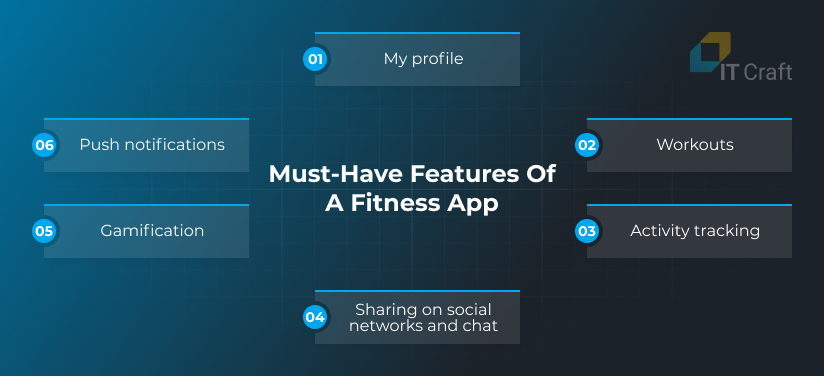
My profile is the main section. This section contains personal information, including gender, age, targets, and achievements. Users can monitor their performance and edit their goals.
Workouts include a list of all workouts available for users. Each workout normally contains the name and description, list of exercises, number of repetitions, etc.
Flexibility is essential when creating a fitness app.
Users need to be able to:
- edit workouts
- add new exercises
- combine them into groups
- create a workout plan
- audio and video support
- trainings categorized by complexity
- workout plans with a defined timeline
This function helps track duration, type, and consistency of sports activity. This can be an activity meter, calorie counter, and robust data collection system. Your fitness app synchronizes with all user devices for data aggregation regarding sleep, calorie intake, etc. Based on aggregated data, users can see how their training affects blood pressure, heart rate, and weight.
- Sharing on social networks and chat
Every fitness application needs a powerful social component. In fact, synchronizing the application with social networks allows users to share their achievements, ask questions, and get information from peers. Your fitness app features can also include chat. This is important for personal training apps because chat lets users communicate with their coaches and each other.
Gamification helps users stay motivated. Gamification features can vary greatly. Jogging apps with challenging quests and winning competitions gain more interest. For example, Zombies, Run! offers a series of interactive missions. Users hear zombies chasing them through their headphones. They must speed up to escape. At the end of each mission, users distribute collected bonuses among users.
Timely notifications to help users stay on track to achieve their goals. When the right motivating messages are sent at the right time, they tend to be a powerful marketing tool.
Technical side of fitness application development
Developers build a fitness app using all three platforms: native, hybrid, and cross-platform.
Budget vs. app complexity determines the technical side of the question “how to create a custom fitness app”:
Developers make a separate app for each platform. Native apps enjoy the best performance, access to native features, and native design.
However, native apps are expensive because development time is lengthy.
Developers maintain one code base for two platforms. They reuse the same codebase using a cross-platform framework such as Flutter, React Native, or Xamarin. Development time is shorter.
Still, developers must adjust the code for each platform. Access to native features can be challenging at times.
The same Web development team can repurpose Web app source code to make it work on mobile platforms. Hybrid approach works best for simple apps. They can be launched fast and within a limited budget.
However, hybrid apps are hard to optimize, and access to hardware could be limited.
Most important fitness app development trends
Successful fitness and workout app development is hardly possible without knowing current trends. The market of fitness and health is growing and changing constantly.
Below are six of the most significant trends to help you create your own fitness app the audience will be waiting for:
According to forecasts, the market of virtual assistants will reach $6.27 billion by 2025. Virtual assistants and trainers will be in demand on sports and fitness apps.
Aaptiv is a pioneer application that offers a virtual personal trainer. This trainer is available 24/7. It shares ideas and tips for an active, healthy, and happy lifestyle via a chatbot. The first virtual personal trainer not only educates users but also keeps learning.
The virtual trainer relies on user data and community information when adjusting to user needs. Interactive elements provide a gamified learning experience to help users stay motivated.
Another trend in fitness app development is Augmented Reality (AR). AR makes training more intensive, both indoors and outdoors. AR allows users to completely get into the world where they interact with objects on smartphone screens.
AR is best suited for real-time data visualization. Users can ensure they avoid physical fatigue. Also, users can increase efficiency because they know exactly when it is possible to increase or reduce performance during the workout session.
How to build your own fitness app where every community member benefits from face-to-face communication? Start real-time online classes. Instructors who want to make their fitness app and improve their brand benefit the most.
For gym instructors, live streaming helps them reach their audience, answer questions immediately, and build a better experience from online lessons.It helps athletes keep their morale while feeling they are not left alone. They can adjust their old habits to their new routine.
Providing access to a knowledge base is equally important. Users might miss a live training session. They might want to find out how to do a certain exercise. Or learn the basics of a healthy diet.
Educational content increases time people spend on the app. It also adds value, saving users’ time to find (and purchase) missing information. Thus, educational content can be another reason to decide on a subscription.
Choice of target platform is an important part of the question “how to make your own fitness app.” Although smartphone penetration is projected to surge up to 77.0% by 2025, demand for wearables such as smartwatches and fitness trackers continues to grow. They accounted for over a quarter of revenue. The reason: trackers collect and make sense of user data, send notification alerts and instructions, and more. A truly seamless experience is possible.
Another benefit is a smart TV app (Apple TV, Chromecast, Amazon Fire TV). A live session or training instructions can be streamed on a big screen letting users focus on exercise and freeing up their hands from holding their smartphones.
Personalization remains one of the key trends. It cannot be underestimated when answering the question “how to make a custom fitness app users will love.” People are looking for the training/diet plans that fit best for their situation.
On-demand programs and personalized plans help users set objectives and provide workout ideas that fit their lifestyles. Machine learning algorithms help keep track of daily progress and correct a plan based on the data.
5
Typical fitness app development costs
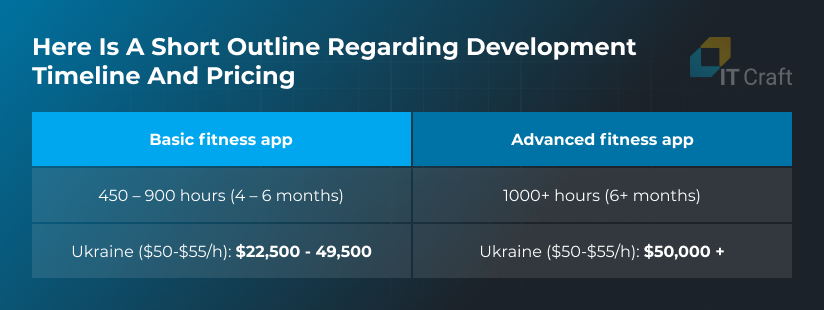
Both Android and iOS apps have a similar development effort, as follows: for both basic Android and iOS apps with similar scope, the effort would take 450 – 900 hours (4 – 6 months) for minimum functionality.
Advanced fitness apps support real-time synchronization, interactivity, and database integration. Users enjoy animations and offline mode (e.g., downloading workout videos). In this case, app development would take 1000+ hours (6+ months).
In both cases, costs might vary. For example, an elaborate app design increases the cost by 20%.
Development costs of such kind of application depend on several parameters. The most important include:
- Number of screens, controls, and fields – the higher the number of those items required, the more expensive the app.
- Types of supported devices – the fitness app can run on smartwatches, trackers, smartphones, or tablets.
- Screen Orientation Modes – recognizing screen orientation type and angle.
- Security – measures to keep data safe.
- Number of supported languages.
- Supported OS versions – app availability on Google Play and/or App Store.
Fitness applications usually work on multiple processes. Normally they have at least 10 screens. Also, fitness apps are integrated with a server and often require payments. Optionally, they have functionality for reviews and feedback and a feature.
How much does it all take? Based on an hourly rate of $50 – $55/hour, typical for a Ukrainian development company, estimated costs to make a custom fitness app vary from $22,500 to $49,500 for the minimum functionality. An advanced app starts from $50,000.
Types of fitness app monetization
App owners should clarify what they intend to charge users and meet their expectations regarding price and provided options.
They can provide access to advanced features, sell goods and services, or provide an app as added value to the main product.
Fitness businesses can rest on one of the following (or several) revenue models:
Users can launch and use the app at no cost to them. In return, businesses regularly display ads. This can be banners, videos, or native ads.This model works best for simple apps with low maintenance costs.
Or the app can become part of a freemium model—users pay for switching off ads. App owners can also encourage users to watch ad videos for bonuses to maximize income.
Pay attention to interruptions. When forced to watch too many ads, users end up looking for better choices.
When delivering the app using a freemium model, the owner provides free basic functionality. Users pay for extended features. For example, a training app can provide one free basic plan. Customized training plans are available upon purchase.
Depending on app complexity and value, app owners can try:
- Upgrades – unlock the full version and remove ads.
- One-time in-app purchases – buy items or in-app currency.
- Subscriptions – pay for app usage regularly.
The subscription model continues to gain popularity because it helps app owners forecast their income. App owners are motivated to provide regular content and feature updates.
One-time purchases can be a safe bet for users. App owners can opt for this model when promoting their MVP.
A rather recent monetization strategy lies in gathering depersonalized user data and selling it to specialized companies. In most cases, for marketing and market study purposes.
For some free apps, data monetization can be more profitable than advertising. Still, app owners should be very cautious about data monetization. They must require user consent upfront and tell users what data type they collect, store, and process. Otherwise, they might ruin their reputation and face legal claims.
- Indirectly as part of added value
Big brands can develop a fitness app as a part of a bigger game. For example, Adidas launched a fitness app called Adidas Training to reach a wide audience and increase loyalty.
Another case is when manufacturers of fitness equipment also create a fitness app. They have the needed experience on how to help users make the most of their devices. For example, Fitbit, a renowned manufacturer of fitness trackers, also provides a special app Fitbit: Health & Fitness, which is very popular (#6 in Health & Fitness on App Store).
Of note: branded apps also offer paid premium subscriptions.
Counterintuitively, app owners can make a custom fitness app that actually pays users for their activities. For example, users get certain points or in-app coins upon reaching the daily workout goal. If they keep meeting goals, they collect a substantial sum of money which they can exchange for gift cards, certificates, discounts, etc. In some apps, they can cash in real money.Alternatively, a fitness application sends money to charities users earn for every mile they walk, run, or cycle.
Another feature to increase motivation and competitiveness is betting. A fitness app works like a betting company. Users make bets using the app on whether they get to the gym or start training at home. Losing money if they don’t is their motivation to keep training
Why not? If the app owner is unsure how to create a fitness app the audience would like, the idea can be tested by starting a crowdfunding campaign. If users are interested in the app idea, they will back it up with money.
In return, the app owner can offer a lifetime subscription, early access to premium features, merchandise, and more options. In addition, the app gets the audience—its first adopters—who provide invaluable feedback.
So, you’ve decided to develop a fitness app…
Moving from theory to real practice is a big decision that requires deep reflection on how to create your own fitness app that users want to use regularly and pay for it.
Consider these brief points to increase your success chances when you start developing a fitness app:
Again, focus on the core functionality to launch fast and on budget. Using the MVP approach, you test the waters to see what users are willing to pay. This is rarely possible on the first try. Develop and launch, market test, rinse/repeat.
Think in advance about how to make a custom fitness app for users who will pay you. Answer the following questions: Are end-users ready to pay for regular subscription or only for a one-time purchase? Will they pay for content or services?
Test different monetization models if you have no definite answer. Provide trials and discounts to help test at no risk. Think about how you engage users to upgrade to the paid version.
You could probably monetize your app through affiliate programs. Team up with a retail business providing gift certificates in return for promotion. Or collaborate with insurance companies. The latter might offer better terms for users who maintain a healthy lifestyle.
Design does require special attention. Users will lose interest if the app looks and feels cheap, no matter how great the features are. Think through what users want to see and what they will want to avoid at any cost.
Fitness applications must support cross-platforms. They must be compatible with as many computing devices as possible: smartwatches, trackers, smartphones, PCs, and TVs.
Data protection is a must-have. When creating a fitness app, enhanced data security is required to prevent leaks of sensitive user data.Also, it’s the law in EU/Schengen countries. Ref. GDPR.
Invest your time looking for developers who know how to make a custom fitness app unless you have an experienced in-house team. Find programmers who can provide your audience with a stellar app.
DO YOU WANT MORE FLEXIBILITY IN DETERMINING FEATURE LIST OF A FUTURE FITNESS APP?
Configure options and get an estimate.
Build My App
!
Conclusion
Mobile apps for fitness show the highest retention rates among all app categories. 96% of users use only one health and fitness app. Unlike other industries, fitness applications remain on users’ smartphones for long.
In the United States alone, the number of health and fitness app users rose from 62.7 million in 2018 to 86.3 million in 2022.
However, fitness app users are becoming increasingly discerning. This means creating and launching a new mobile fitness app becomes more challenging for business owners. This is where business owners must unleash their creativity and follow best practices.
To design and produce a new fitness app, product owners need:
- a scope of work
- a clear vision of audience expectations
- a well-built survival strategy
- a team capable of turning a set of requirements into a polished app
Are you curious to know how much your fitness app can cost you at IT Craft?
Contact us today and get a free roadmap with costs, technologies, and timeline for your project.





















